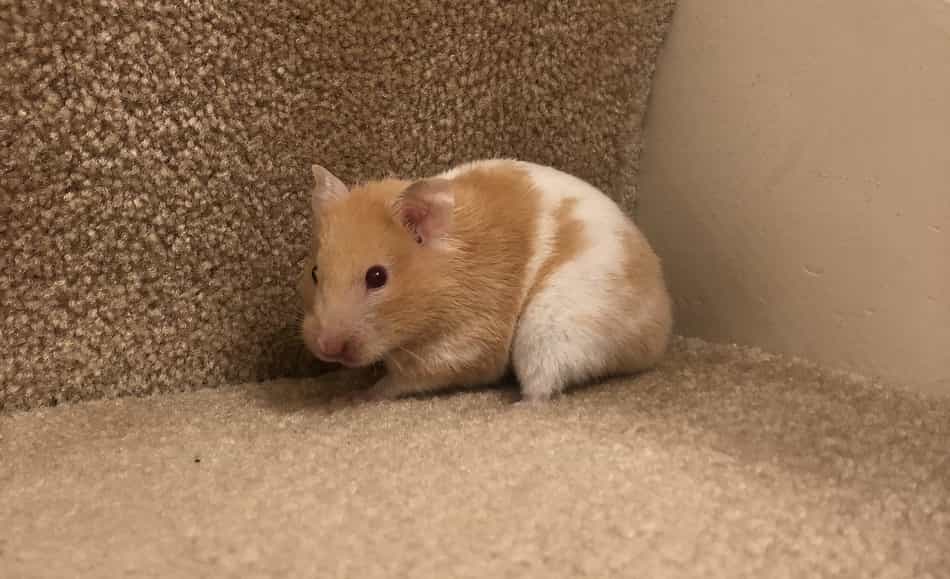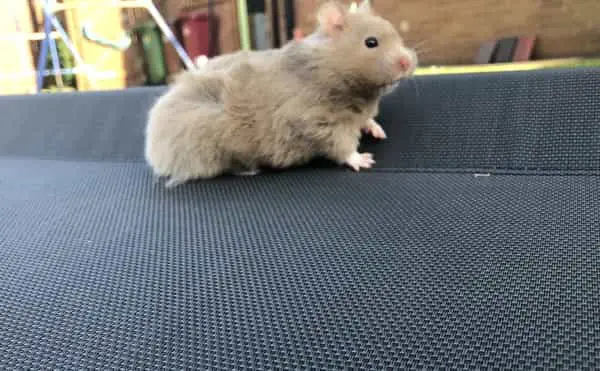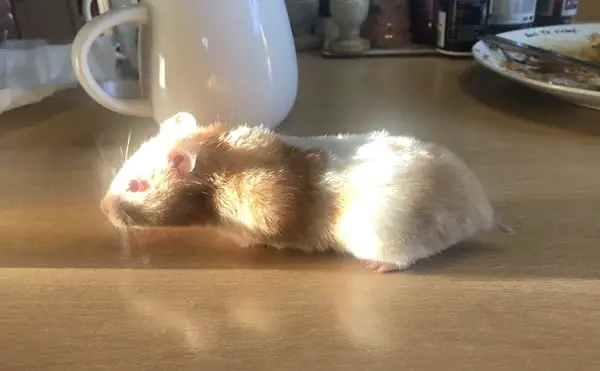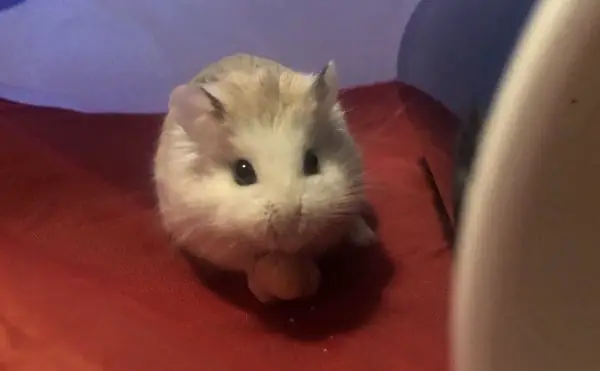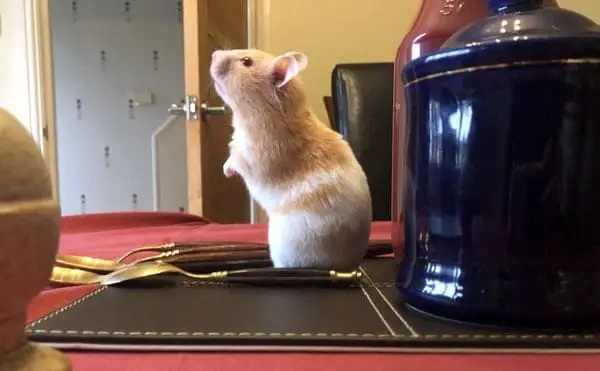Many people know that hamsters make great pets for various reasons, including how adorable they are! However, sometimes it can come as quite a surprise to learn how much energy is jam-packed into their tiny little bodies. This can make anyone question whether they should liberate their tiny pals from their enclosures every now and then.
So, can I let my hamster run around my room? Under close supervision, hamsters can be let to run around in a room. Despite that possibility though, there are many factors to consider when free roaming for the safety of your hamster.
In this article we will talk about the benefits of letting your hamster wander, safety hazards of which to be aware, and how to free roam safely. We will also discuss hamsters’ propensity for escape acts and a safer, easier alternative to designating an entire room for free play.
Where the Hamsters Roam
If you have ever watched your furry friend run relentlessly on its exercise wheel, scamper endlessly through its tunnels, or dig until it drops, and wonder if perhaps it would benefit from some time out of its enclosure—the answer is yes, very much so!
Wild hamsters run for miles every night to forage for food and use intense amounts of energy to dig their intricate tunnels, some of which have been known to be up to eight feet deep!
They also consume a high-powered diet packed with carbohydrates to support their extremely busy lifestyles. Knowing how spirited and curious hamsters are, it almost seems silly to think our domestic companions should spend all their time inside an enclosure.
Enter the fun and little-known concept (in the hamster world, anyway) of “free roaming.” This means that, under supervision, you can let your pocket-sized pal out of its enclosure to run around a safe, designated area to its heart’s content.
Free roaming for your little pal is great mental stimulation, which hamsters need very much. It is also obviously a great source of physical exercise, which, as mentioned above, is great for our high-energy companions.
This kind of enrichment can go quite a long way in preventing complications from boredom or stress to which hamsters are quite prone. It also promotes overall good health and wellbeing for your pal.
How Long Should I Let My Hamster Free Roam?
The beauty of free roaming your companion is that you can let them go for as long as they want—for some hams, 20-30 minutes will suffice, while other, more energetic, hamsters may want to romp around for hours. Watch your companion’s body language to determine how long or short your sessions should be.
Your pet likely will want to explore every inch of this new area out of curiosity, so allow them to do so. Once they have slowed down or stopped to take refuge in a hide, or they are grooming, yawning, or stretching, they are likely calm and content enough to put back into their enclosure for the day.
Before you decide free roaming is for you, it is especially important to make sure the area in which you plan to let your pal run around is safe.
Safety Hazards
To safely free roam your companion, you must first “hamster-proof” the area you have designated for exploration. Giving your hamster such a huge, new space could be overwhelming at first, but rest assured, once it adjusts, it will get into every nook and cranny possible.
Further, it likely will leave no surface unclimbed or unchewed, so hamster-proofing the area is paramount to free roaming success and safety.
To hamster-proof, remove or securely cover ground-level electrical cords, double check any surface area in which your hamster might climb (hint: pretty much every surface in the room) for exposed cords, and cover electrical outlets.
Electrical cords make great chewing for our little pals, which means they are exposed to electric shock at worst, and ingestion of foreign materials at best. Examine the room for any loose materials or detritus on the floor—anything on the floor is fair game for chewing, so leave clothing or personal belongings on the floor at your own risk!
Again, ingestion of foreign material or food could pose a serious risk to your pal’s digestive tract, so keep the area clean and give it a once-over with your vacuum before play time for good measure.
Additionally, your hamster is at risk from climbing. Hamsters do not have great eyesight or depth perception, which often leads to them climbing something just to leap from it with abandon.
These leaps of faith can lead to serious injury, depending on the height from which they jump, so make sure to remove large pieces of furniture from the room, or be prepared to chase your pal around to prevent them from jumping.
Further, your hamster may climb up or into furniture and wedge themselves through wardrobe doors or drawers. They may also climb up the back of furniture and get into the backing material of couches or chairs.
In addition to the falling risk this behavior poses, hamsters could also get themselves stuck where you cannot find them, or injure themselves being pinched in drawer rollers, recliner gears, dresser doors, etc. Beyond removing furniture altogether, try moving it away from walls so you can easily reach your daredevil pal should they attempt one of these feats.
Some free roaming hazards include stress-inducing situations such as becoming overwhelmed with the size of the space, as mentioned earlier. Be sure to put out plenty of hides and/or tunnels for your tiny friend to seek refuge in and help them adjust to being in such an expansive area.
You should also provide lots of toys or even a sand bath to make the space more welcoming. Furthermore, having large pets or particularly rambunctious children in the room may also cause stress.
Have your kids speak in calm, gentle tones to the extent possible when they are in the room with your roaming hamster. Finally, keep large animals, especially predatory ones like dogs and cats, out of the room while your pal wanders.
In addition to safety hazards, you must also account for your hamster’s natural ability to pull a disappearing act when hamster-proofing your free roam area.
Now You See Them, Now You Don’t
Any hamster owner will tell you that their pocket-sized pals seem like they can almost defy the laws of physics when it comes to squeezing into, or out of, certain places. Being so curious and almost magical in their ability to get out of things, escape attempts from their enclosures become almost commonplace for many hamsters.
This means it is imperative to set yourself up for success by securing the designated area from your furry friend’s Houdini-like antics.
In addition to the previous suggestions of removing furniture where possible, close all doors and windows securely. Closely examine the baseboards and corners of your room to ensure there are no holes or gaps in the wall through which your companion can escape.
Further, cover any gaps beneath doors with something heavy enough that your mischievous little pal cannot push or pull it out of the way. Do not forget the door to your closet or bathroom, as the additional space just offers even more opportunity to escape into the ether of your home.
If you do happen to lose track of your tiny friend, do not panic! There are a few things you can do to safely locate them again. Check all pieces of furniture in the room; behind, beneath, between or inside cushions, in drawers or behind doors, etc. Look inside bags, backpacks, or shoes you may have in the area.
Look in connecting or adjoining spaces (i.e., closet or bathroom) and in all nooks and crannies therein. Be as thorough as possible when searching and leave your hamster’s enclosure door open with their favorite treats inside in the meantime.
Further, put a little food or some favorite treats in front of any areas you think they could have escaped into to lure them out, and listen closely for movement where you suspect your pal may be hiding. Be patient and use this mishap as a learning experience for next time you free roam!
If you want your furry friend to have more time outside their enclosure, but cannot free roam in an entire room, consider this safer alternative: a playpen!
Not Just for Babies
If you are unable to hamster-proof a whole room for any reason, be it that you are short on space or time, or simply do not want to chase a hamster around a room all day, a playpen is a safe, fun alternative. An ideal playpen for hamsters should be made of fabric or storage panels, although a commercial wire playpen will work if the grid is not too wide.
Using a playpen ensures plenty of free roam time while not having to worry about safety hazards or potential escape routes. These are also ideal for dwarf breeds, who are much easier to lose track of in a large space than their bigger Syrian cousins.
Playpens are also great for bonding with new hamsters, as you can sit inside with them, but they can still maintain their personal space while they adjust to you. As with a free roam room, provide plenty of hides and enrichment for your pal while they play.
A hamster ball is another viable way to give your pet time outside of its enclosure, however, it is not wise to let them roll around for longer than about 15 to 30 minutes.
Ventilation in many balls is not ideal for long periods of time, a hamster will not be able to hold its urine or feces for much longer than about 30 minutes, and since the ball is quite heavy to our tiny friends, exhaustion can set in quickly.
Conclusion
If you are wondering whether letting your hamster free roam is the right move, you are correct! Hamsters have lots of energy and letting them roam in a new space is great for their health and wellbeing.
There are plenty of safety hazards to consider, so make sure you fully hamster-proof the designated area prior to letting your pal roam, and always supervise their activity. Further, hamsters are escape artists, so secure the area as much as possible lest you lose your tiny friend.
Finally, if free roaming is not an option for you, consider a playpen as a fun, safe alternative. If you give your pocket-sized pal time to explore the big world outside of their enclosure, they will thank you for it by living a long, happy life with you by their side!

